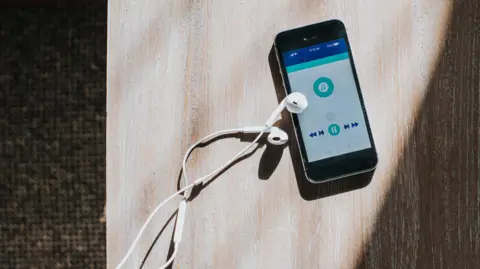 Getty Images
Getty ImagesThe 2018 film The Grinch was the most-watched programme in Northern Ireland in 2024, according to Ofcom.
Episodes of BBC shows Blue Lights and Gavin and Stacey were the next most popular.
The details were contained in the regulator’s just-published Media Nations report for Northern Ireland.
It also said viewers in Northern Ireland watched more live TV that those in other parts of the UK.
According to Ofcom, The Grinch was watched by more than 630,000 viewers in Northern Ireland in 2024.
The first episode of series two of Blue Lights on the BBC drew 556,000 viewers.
Next highest figures were for the finale of Gavin and Stacey on the BBC with 478,000 watching.
Other shows in the top 10 in Northern Ireland included ITV’s I’m a Celebrity Get Me Out of Here! and Mr Bates vs The Post Office.
Do people still watch a lot of TV in Northern Ireland?

TV is watched more by older viewers, with those aged between four and 24 only watching about half an hour a day.
Viewers in Northern Ireland also tend to be happy with what they get from the BBC, UTV and Channel 4, with about three-quarters telling Ofcom they are “very satisfied” or “satisfied”.
But the rise of video-on-demand services continues.
Almost six-in-10 homes in Northern Ireland subscribe to Amazon Prime.
It is more popular in Northern Ireland than Netflix, which is present in around 55% of homes.
BBC iPlayer is the most popular video-on-demand service from public service broadcasters such as the BBC, ITV, Channel 4 and Channel 5.
Over a quarter of viewers (26%) use BBC iPlayer every week.
 Conor Barton
Conor BartonConor Barton says digital streaming and on-demand content now shape almost all his media habits.
The 26-year-old said the “vast majority” of content he watched was through YouTube.
“It’s tailored to my interests and available instantly – unlike traditional TV,” he said.
His live television viewing is mostly limited to sports and major events:
“Specials like Gavin & Stacey are exceptions,” he said.
“Otherwise, I’d only use terrestrial TV if something isn’t on a digital platform.
“Young people stream because that’s what we know – it’s part of daily life now. It’s the on demand, instant access that makes the difference”
What about social media sites like YouTube or TikTok?
Youtube is the most-popular social media video platform, with three times as many viewers in Northern Ireland as TikTok, the next most popular.
According to Ofcom, just over two-thirds (67%) of adults aged 16-34 watch at least three minutes of YouTube a week.
But those who use YouTube spend an average of 35 minutes a day viewing content on it.
 Stacey Burns
Stacey BurnsStacey Burns from Lisburn is a fan of short-form video and uses TikTok.
She said she spends about an hour a day scrolling.
“You don’t have to concentrate much on TikTok as it’s short and snappy content, and that’s what I like about it,” the 27-year old said.
“I consume very little live TV unless it is a music or sporting event being broadcast.
“As a child, I would have made sure I was home in time for my favourite shows; however, it just doesn’t work with my schedule anymore – I would rather have something I can watch at any time.
“I’m more likely to sit down and watch TV on the weekend when I have time.
“It would be via streaming services.
“Maybe a series that I’m watching – I’ll get properly into watching something when I have more time.”
How do people get their news?
BBC TV remains the most popular source of news in Northern Ireland, according to Ofcom.
More than four-in-10 adults said they got their news mainly from news programmes broadcast on BBC or UTV.
Aside from BBC and UTV, though, Facebook is the third most popular way for people to get news in Northern Ireland.
Almost 20% of adults told Ofcom they used Google or the BBC News website or app to access news.
Overall viewers in Northern Ireland are more likely to watch news programmes on TV than those in England, Scotland or Wales.
What about radio?
 Getty Images
Getty ImagesRadio listening is higher in Northern Ireland than elsewhere in the UK, with almost nine-in-10 adults tuning into radio each week.
The station with the biggest share of listeners is BBC Radio Ulster, followed by Cool FM and Downtown, according to Ofcom.
Ofcom also said that despite the growth of digital radio, more people in Northern Ireland still listen to radio live on AM or FM.
But just under seven-in-10 people use online music services such as Spotify or Apple Music at least once a week.
According to Ofcom, podcast listening is less popular in Northern Ireland than elsewhere in the UK.




